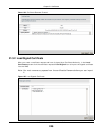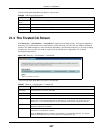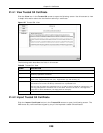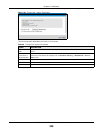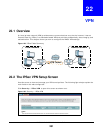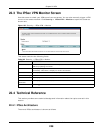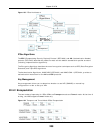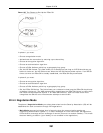
Chapter 22 VPN
VMG5313-B10A/-B30A Series User’s Guide
254
IP Address for
VPN
If Single Address is selected, enter a (static) IP address on the LAN behind your VMG.
If Subnet is selected, specify IP addresses on a network by their subnet mask by entering
a (static) IP address on the LAN behind your VMG. Then enter the subnet mask to identify
the network address.
IP Subnetmask If Subnet is selected, enter the subnet mask to identify the network address.
Tunnel access
from remote IP
addresses
Select Single Address to have only one remote LAN IP address use the VPN tunnel.
Select Subnet to specify remote LAN IP addresses by their subnet mask.
IP Address for
VPN
If Single Address is selected, enter a (static) IP address on the LAN behind the remote
IPSec’s router.
If Subnet is selected, specify IP addresses on a network by their subnet mask by entering
a (static) IP address on the LAN behind the remote IPSec’s router. Then enter the subnet
mask to identify the network address.
IP Subnetmask If Subnet is selected, enter the subnet mask to identify the network address.
Protocol Select which protocol you want to use in the IPSec SA. Choices are:
AH (RFC 2402) - provides integrity, authentication, sequence integrity (replay
resistance), and non-repudiation but not encryption. If you select AH, you must select an
Integraty Algorithm.
ESP (RFC 2406) - provides encryption and the same services offered by AH, but its
authentication is weaker. If you select ESP, you must select an Encryption Agorithm
and Integraty Algorithm.
Both AH and ESP increase processing requirements and latency (delay). The VMG and
remote IPSec router must use the same active protocol.
Key Exchange
Method
Select the key exchange method:
Auto(IKE) - Select this to use automatic IKE key management VPN connection policy.
Manual - Select this option to configure a VPN connection policy that uses a manual key
instead of IKE key management. This may be useful if you have problems with IKE key
management.
Note: Only use manual key as a temporary solution, because it is not as secure as a regular
IPSec SA.
Authentication
Method
Select Pre-Shared Key to use a pre-shared key for authentication, and type in your pre-
shared key. A pre-shared key identifies a communicating party during a phase 1 IKE
negotiation. It is called "pre-shared" because you have to share it with another party
before you can communicate with them over a secure connection.
Select Certificate (X.509) to use a certificate for authentication.
Pre-Shared Key Type your pre-shared key in this field. A pre-shared key identifies a communicating party
during a phase 1 IKE negotiation.
Type from 8 to 31 case-sensitive ASCII characters or from 16 to 62 hexadecimal ("0-9",
"A-F") characters. You must precede a hexadecimal key with a "0x” (zero x), which is not
counted as part of the 16 to 62 character range for the key. For example, in
"0x0123456789ABCDEF", “0x” denotes that the key is hexadecimal and
“0123456789ABCDEF” is the key itself.
Local ID Type Select IP to identify the VMG by its IP address.
Select E-mail to identify this VMG by an e-mail address.
Select DNS to identify this VMG by a domain name.
Select ASN1DN (Abstract Syntax Notation one - Distinguished Name) to this VMG by the
subject field in a certificate. This is used only with certificate-based authentication.
Table 101 Security > IPSec VPN: Add/Edit
LABEL DESCRIPTION



